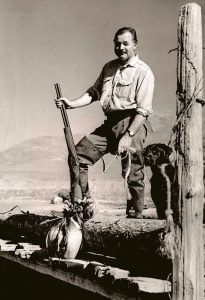What a newly discovered treasure trove of Ernest Hemingway materials reveals about the author

Associated Press
After sitting for decades in a storage room in Sloppy Joe’s Bar in Key West, Florida, Ernest Hemingway’s favorite bar, a treasure trove of materials belonging to the author could change the way we think about the him.
Unpublished short stories, manuscripts, photos, letters and correspondences and more have been made available to the public and scholars for the first time through the Toby and Betty Bruce Collection of Ernest Hemingway at Penn State University.
From fishing logs and his American Red Cross Uniform, to drafts and galleys of his book “Death in the Afternoon,” the collection is full of artifacts that should make any Hemingway fan excited. Robert K. Elder in The New York Times even called it the “the most significant cache of Hemingway materials uncovered in 60 years.”
Boxing with F. Scott Fitzgerald
Among the findings, is an amusing unpublished three page short story about “Kid Fitz”— a satire of F. Scott Fitzgerald — as a young boxer who fights other famous authors with comedic boxing names such as “Battling Milton,” “K.O. Keats,” “Spike Shelley” and “Wild Cat Wordsworth.”
“It’s making fun of Fitzgerald’s ineptitude in physical manners,” Fitzgerald scholar Kirk Curnutt told The New York Times. “Hemingway clearly felt he’d surpassed Fitzgerald in literary and physical virility.”
Perhaps the story is a reference to the 1929 boxing match between Hemingway and Canadian writer Morley Callaghan in which Fitzgerald, who was timing the match, allegedly let the match go on for a minute too long. Hemingway blamed Fitzgerald for losing the match, and the grudge apparently lasted.
Additionally, Hemingway often compared boxing to writing, imagining himself going up against some of the world’s greatest writers.
In a 1949 letter to Charles Scribner, Hemingway writes that he could take Henry James down with one hit.
“There are some guys nobody could ever beat like Mr. Shakespeare (The Champion) and Mr. Anonymous,” Hemingway wrote. “But would be glad any time, if in training, to go twenty with Mr. Cervantes in his own home town (Alcala de Henares) and beat the (expletive) out of him.”
The “Kid Fitz” short story is a continuation of Hemingway’s pattern of comparing authors to each other through boxing imagery, but this time, rather than comparing himself to others, he shows Fitzgerald engaging in this same act of authorial comparison.
“In a way, it’s an odd admission of delusion,” Curnutt said. “Hemingway would claim he could take world-renowned writers in the ring with the same sort of obliviousness he’s attributing to Kid Fitz here as he gets his nose knocked off.”
Musing on death and suicide
In some less light-hearted writings found in the collection, Hemingway contemplates death and suicide, over 35 years before he would take his own life.
In personal writings from the archive, dated March 6, 1926, he writes, “When I feel low I like to think about death and the various ways of dying and I think probably the best way, unless you could arrange to die some way while asleep, would be to go off a liner at night.”
“For so many years I was afraid of death and it is very comfortable to be without that fear. Of course it may return again at any time,” Hemingway continued.
The writings suggest that the “author’s own suicidal ideation started earlier and was perhaps deeper than scholars previously knew.” Elder writes.
From his personal writings, scholars will have much more information on the inner workings of Hemingway’s mind than they’ve had before. As Elder states in his article in The New York Times, this is just a first look at many more potential findings from this exciting collection.
As scholars dig deeper into the collection, we will find out even more about the personal life — the inner thoughts, the writing process, the contemplations of suicide — of the seemingly larger-than-life author.





























